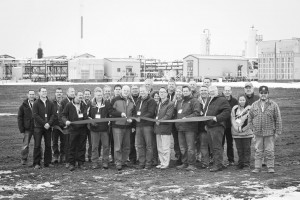Nexen marks grand opening with ribbon cutting – Tsea compression station marks major milestone in NEBC shale gas program

Official ribbon cutting of the Tsea Compression Station was marked by NRRM Councillors Danny Soles and Todd Osborne flanking Kevin Reinhart, Nexen’s Interim President & CEO, Ron Bailey, Senior Vice President, Natural Gas (Canada) & OST, and Mr. Masaki Ogihara, Director & Vice President, IGBC (INPEX GAS British Columbia) with MP Bob Zimmer and MLA Pat Pimm. Others attendees also included, industry representatives, local and Aboriginal stakeholders, and Nexen employees.
On October 19th, Nexen celebrated the grand opening of its Tsea Compression Station (pronounced Te-SEE-ah meaning baby moose in Slavey, an Athabaskan language spoken among the Slavey First Nations) in the Horn River Basin, a key milestone in their Canadian shale gas operations.
At a ribbon cutting ceremony, Nexen acted as host and tour guide as representatives from government and industry, Aboriginal stakeholders and key contractors toured the compression facility and field.
The compressor station tour also highlighted Nexen’s evolving well pad designs, the 300-person Dilly Creek main camp and the drilling rig currently developing a 20 well pad.
Following the field tour, a catered lunch was held for attendees where Kevin Reinhart, Interim President & CEO, and Ron Bailey, Senior Vice President, Natural Gas (Canada) & Operational Services Technology (OST), discussed Nexen’s commitment to responsible development and emphasised that on-going support from the community, First Nations and government has been key in Nexen’s success in northeast British Columbia.
Tsea Compressor Project
The Tsea Compressor Station located 80 km northeast of Fort Nelson, British Columbia, started production on September 21st, 2012.
It represents the most recent phase in Nexen’s shale gas development strategy in the Horn River Basin, which began in 2008 with the construction of the smaller, nearby Etsho Compressor Station.
Tsea has an initial capacity of 150 million cubic feet per day (mmcf/d) of raw natural gas and enables Nexen to boost total production capacity to 175 mmcf/d from 50 mmcf/d.
The facility compresses and dehydrates gas from shale gas wells. This gas is pipelined to third-party processing facilities where carbon dioxide and hydrogen sulphide are removed to meet specifications for domestic gas usage.
The station is currently fed from one 18-well production pad. The compressor station is designed to produce gas from the area for over 50 years. The project was conceived in January 2010 and design started in June 2010. Major equipment orders were placed in early 2011 and on-site construction began in November 2011.
First Nations Engagement
The ceremony was also an opportunity for Nexen to further demonstrate their commitment to engaging with Aboriginal communities and Fort Nelson First Nations.
Nexen was pleased to welcome Ignace Burke, a local trapper, and his daughter Vicki to the event. “Ignace and his family have been trapping in the area for decades, and his insights are invaluable to helping us better understand the ecological and social dynamics of the area,” says Scott Wagner, Community Consultation & Regulatory Affairs Advisor.
“We continue to develop strong working relationships with respect to Aboriginal employment and business development opportunities, as well as ensuring we are conducting our activities in a respectful and environmentally responsible manner.”

 Follow
Follow



Recent Comments